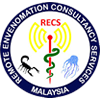Trimeresurus venustus
Taxonomy
-
Kingdom
-
Phylum
-
Class
-
Order
-
Family
-
Genus
-
Specific Epithetvenustus Vogel, 1991
-
Synonym
- Cryptelytrops venustus Malhotra & Thorpe, 2004
-
Common Name
- Beautiful Pit Viper (English)
- Beautiful Pitviper (English)
- Brown-spotted Pit Viper (English)
- Ular Kapak Cantik (Malay)
-
ResidentialNative
Description
The beautiful pit viper was about 35 – 70 cm in size. This venomous pit viper has an elongated and slender body with keeled dorsal scales. It has a triangular head which is distinct from the neck in green colour with an irregular brown or purplish blotches. The pit organ is present in front of its eyes. The colour of this pit viper is dark green with brown or purplish irregular zigzag shapes along the body while the progressive tail is brown with green dots and the ventral scale is pale green (Sibunruang et al., 2013).
Habits
| No | Part | Habit | |
|---|---|---|---|
| 1 |

|
Venomous — Capable of injecting venom by means of a bite or sting.
|
Assessment
| Year Published | Assessment | Red List Category | Version |
|---|---|---|---|
| 2021 | IUCN Red List of Threatened Species |
Vulnerable (VU)
Peninsular Malaysia
|
3.1 |
Emergency Contact
Biodiversity Experts
| Profile | |
|---|---|
|
Amirrudin Bin Ahmad (Dr.)
Universiti Malaysia Terengganu (UMT)
|
Amphibians, Dragonflies and Damselflies, Fishes, Reptiles,
Biodiversity, Data Analysis, Digital Sequence Information (DSI), Living Modified Organism (LMO), Marine & Coastal, Protected Areas & Invasive Alien Species
|
|
Chen Pelf Nyok (Dr.)
Turtle Conservation Society of Malaysia (TCS)
|
Turtle, Tortoise, and Terrapin (Ecology), Reptiles (Ecology),
Biodiversity, Conservation, Education & Environment
|
|
Kaviarasu Munian (Mr.)
Forest Research Institute Malaysia (FRIM)
|
Reptiles (Ecology), Amphibians (Ecology), Fishes (Ecology),
|
|
Lim Boo Liat (Dr.)
|
Reptiles (Ecology), Rodents (Ecology), Amphibians (Ecology),
Biodiversity, Ecosystems & Invasive Alien Species
|
|
Mohammad Shahfiz Azman (Mr.)
Forest Research Institute Malaysia (FRIM)
|
Amphibians, Mammals, Birds, Amphibians, Reptiles,
Awareness, Biodiversity, Conservation, Ecosystems, Environment, Forest, Landscape, Law and Policy, Management, Protected Areas, Science, Systematics, Invasive Alien Species, Like-Minded Megadiverse Countries (LMMC), National Policy on Biological Diversity, Policy, Research and Development (R&D) & Zoonotic
|
|
Mohd Abdul Muin Bin Md Akil (Mr.)
Universiti Sains Malaysia (USM)
|
Amphibians, Birds, Reptiles, Snakes,
Biodiversity, Conservation, Evolution, Genetics, Molecular, Protected Areas, Climate Change & Invasive Alien Species
|
|
Mohd Uzair Rusli (Assoc. Prof. Dr.)
|
Turtle, Tortoise, and Terrapin, Reptiles,
Conservation, Data Analysis, Ecology & Marine & Coastal
|
|
Mohd Zulfadli Bin Mohd Arshad (Mr.)
Department of Wildlife and National Parks (PERHILITAN)
|
Rodents (Taxonomy), Reptiles,
Molecular, Biodiversity & Science
|
|
Norhayati Binti Ahmad (Prof. Dr.)
Universiti Kebangsaan Malaysia (UKM)
|
Frogs and Toads, Snakes, Amphibians, Reptiles,
|
|
Teo Eng Wah (Dr.)
University of Malaya (UM)
|
Reptiles, Amphibians,
Invasive Alien Species
|
References
- Fuchs, J., Bessire, K. & Weiler, S. (2019). A confirmed bite by a Beautiful Pit Viper (Trimeresurus venustus) resulting in local symptoms. Toxicon. 163, 44-47. https://www.sciencedirect.com/science/article/abs/pii/S0041010119300935
- Lim, B.L., Noor Alif Wira, O., Chan, K.O., Daicus, B. & Norhayati, A. (2010). An Updated Checklist of the Herpetofauna of Pulau Singa Besar, Langkawi, Peninsular Malaysia. Malaysian Applied Biology Journal 39 (1), 13-23. https://www.researchgate.net
- Qamruddin, R.M., Safferi, R.S., Mohamed@Ismail, Z., Salleh, M.S., Abd Hamid, M.N.H., Frederic Ng, V.E.R., Goh, W.C. & Ismail, A.K. (2023). Frequency, geographical distribution and outcomes of pit viper bites in Malaysia consulted to Remote Envenomation Consultancy Services (RECS) from 2017 to 2020. PLoS Neglected Tropical Diseases, e0011569. http://doi.org/10.1371/journal.pntd.0011569
- Guideline: Management of Snakebite, 2017. Ministry of Health Malaysia, Putrajaya, Malaysia. — [ Adobe PDF (PDF) ]
- Guidelines for the Management of Snakebites, 2nd edition, 2016. WHO Regional Office for South-East Asia, New Delhi, India. pp. 206.
- Heritage of Kubang Badak: Guide to Discover Kubang Badak Biogeotrail, 2018. Pusat Penyelidikan Langkawi, Universiti Kebangsaan Malaysia & Lembaga Pembangunan Langkawi, Malaysia. pp. 62.
- Snake Farm Exhibition, 2010. Snake Farm, Queen Saovabha Memorial Institute, The Thai Red Cross Society, Thailand. pp. 97.
- Das, I. (2010). A Field Guide to the Reptiles of South-East Asia. New Holland Publishers (UK), England. pp. 369.
- Ismail, A.K., Teo, E.W., Das, I., Vasaruchapong, T. & Weinstein, S.A. (2017). Land Snakes of Medical Significance in Malaysia. Ministry of Natural Resources and Environment, Putrajaya, Malaysia. pp. 80. — [ Adobe PDF (PDF) ] — [ | eBook (EPUB) ]
- Ismail, A.K., Teo, E.W., Das, I., Vasaruchapong, T. & Weinstein, S.A. (2022). Land Snakes of Medical Significance in Malaysia. 3rd Edition. Forest Research Institute Malaysia (FRIM), Malaysia. pp. 87. — [ Adobe PDF (PDF) ]
- Norhayati, A., Daicus, B. & Chan, K.O. (2021). Ular Darat Malaysia / Land Snakes of Malaysia. Penerbit UKM, Malaysia. pp. 100.
- Sibunruang, S., Suteparuk, S. & Sitprija, V. (2013). Manual of Practical Management of Snake-bites and Animal Toxin Injury. Bangkok: Queen Saovabha Memorial Institute, The Thai Red Cross Society, Thailand. pp. 88.
Publications
Related by Genus
Acknowledgements :- Mr. Ahmad Amir Firdaus Bin Mad Apandi, Ms. Ajla Rafidah Baharom, Ms. Noor Amira Aini Binti Noor Anwar, Ms. Nor Liyana Binti Hassan, Ms. Norazah Binti Norddin, Mrs. Nur Hazwanie Binti Abd Halim, Mrs. Nurfarhana Hizan Binti Hijas, Mr. Tan Kok Kiat & Mr. Yasser Mohamed Arifin
Photo credit :- Norhayati Binti Ahmad
Species Citation :- Trimeresurus venustus. Malaysia Biodiversity Information System (MyBIS). Accessed via https://www.mybis.gov.my/sp/53771. [Retrieved 14 May 2024].
Feedback :- If you see any errors or have any questions or suggestions on what is shown on this page, please provide us with feedback.

